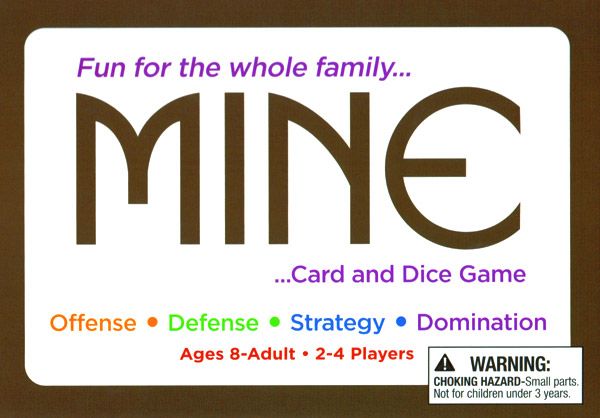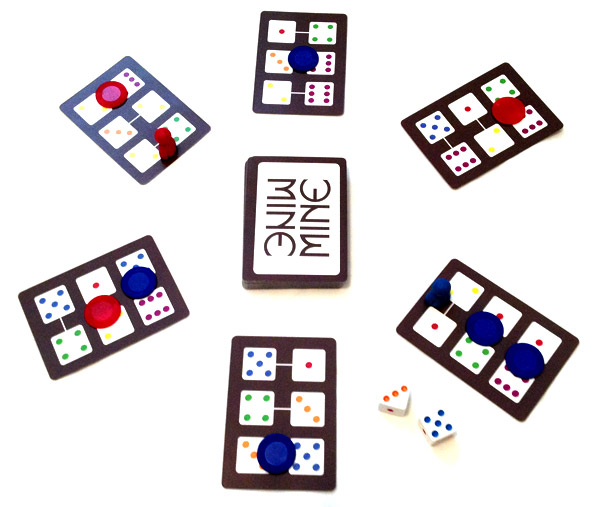Rolling for Cards: A Review of Mine

Here's an interesting fact for you: dice have been used since before recorded history, and it is uncertain where they originated. The oldest known dice were excavated as part of a 5000-year-old backgammon set at the Burnt City, an archeological site in south-eastern Iran (source: Wikipedia). Yet these ancient artifacts are still in extremely wide use, presumably because we just love rolling them.
Mine, by KTP Games, is not about mining, as some may presume. Instead, it is an abstract dice game in which players try to roll certain combinations of dice to gain ownership of game cards ("That card is MINE!"). It's not much to look at, but is there a fun game here?
Gameplay
In Mine, players try to be the first to collect a certain number of Mine cards (ranging from 3 to 5, depending on the number of players). A number of cards are laid out on the table, face up. Each card contains three different pairs of numbers. Players take turns rolling the two dice to try to match the pairs of numbers displayed on the cards. If a match is made, the player places a chip of his color on that spot. If he controls all three pairs on the card, he calls out, "Mine!" and adds the card to his hand. A new card is then drawn and placed on the table to replace the old one.
If there are matches on multiple cards, the player chooses which one to claim with his chip. If there are no matches available except one that is already claimed by another player, the current player may replace the existing token with his own. Each player also has a pawn, which he may use to "freeze" a card that contains only tokens of his own color. This prevents an opponent from adding or removing chips on that card.
If doubles are rolled, the player may decide to either place a chip on any available space, remove another player's chip that is already in play, or remove an opponent's pawn from a frozen card (which can't be used again for two more turns).
The first player to collect the designated number of Mine cards wins.
An "Ultimate Play" variant is also included with the game, which continues gameplay for three rounds. In this version, players keep their opponents' chips when taking over a spot, rather than returning them to the owner. These chips are totaled and added to a scoresheet at the end of the round. The player who "won" the round by collecting the designated number of cards also rolls a bonus die to earn up to 3 additional points. The player with the most points after three rounds wins the game.

Review
Mine is an easy-to-learn game that can have some fun moments when luck is on your side. The design is rather simplistic in its presentation, and the components included with the game are nothing special in terms of originality. But the included zipper bags and clear plastic card box are nice for keeping the game organized between plays.
Unlike other dice games that use the sum of the dice, probabilities don't come into play in this game, since the probability of rolling each pair is identical. Instead, the key strategy lies in the interaction between players, who are all battling over the same cards. When choosing between multiple options, you will want to consider which one will either limit your opponents' available options the most, or reduce the chance that your own chips will be replaced. The most consequential choice occurs when rolling doubles, which offers options that are quite powerful and can help swing the game. Other choices are more subtle, but can make a difference.
While the game offers some choices to be made, these choices are not available on every turn. If you roll the dice and there are no matches available, your turn is over. There is no option to re-roll or take any other action in this case, which leaves unlucky players frustrated. Similarly, if you roll a pair for which there is only one match available, you don't have any choice in the matter (unless you need to decide whether or not to replace an opponent's chip). In this regard, the ability to use any strategy on a turn is highly dependent on the luck of the dice roll.
The game largely consists of searching for the pairs that are rolled, which can become a bit tedious, especially because the chips on the cards partially cover up the dice images. Fortunately, the numbers on the dice are color-coded — however, since the numbers themselves don't matter, it would be preferable to have just colors on the dice (possibly combined with large shapes) to make them more easily distinguishable. Better yet, adding a light theme, such as diamonds other jewels that are being mined (perfect for the title) could really add a bit of flair to an otherwise bland abstract game.
While there are several improvements to be made to Mine, there is still some fun to be had for players who enjoy classic family games like Uno and Sorry. Personally, I would recommend games like Can't Stop and Excape as better alternatives in this genre.
Pros: fast-paced and casual play, some strategy involved
Cons: many turns provide no choices at all, bland presentation, could be more user-friendly
Disclosure: we received a complimentary review copy of this game.




